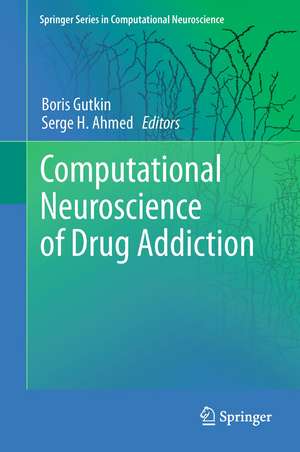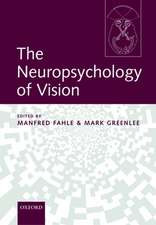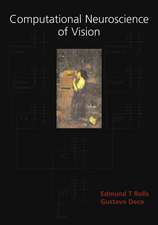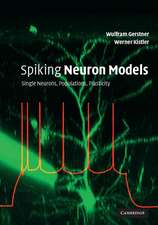Computational Neuroscience of Drug Addiction: Springer Series in Computational Neuroscience, cartea 10
Editat de Boris Gutkin, Serge H. Ahmeden Limba Engleză Paperback – 28 noi 2013
| Toate formatele și edițiile | Preț | Express |
|---|---|---|
| Paperback (1) | 1210.64 lei 6-8 săpt. | |
| Springer – 28 noi 2013 | 1210.64 lei 6-8 săpt. | |
| Hardback (1) | 1215.32 lei 6-8 săpt. | |
| Springer – 26 oct 2011 | 1215.32 lei 6-8 săpt. |
Din seria Springer Series in Computational Neuroscience
-
 Preț: 383.55 lei
Preț: 383.55 lei - 18%
 Preț: 947.58 lei
Preț: 947.58 lei - 24%
 Preț: 1173.14 lei
Preț: 1173.14 lei - 23%
 Preț: 1342.24 lei
Preț: 1342.24 lei - 18%
 Preț: 1116.48 lei
Preț: 1116.48 lei - 18%
 Preț: 950.08 lei
Preț: 950.08 lei - 5%
 Preț: 1414.36 lei
Preț: 1414.36 lei - 18%
 Preț: 954.64 lei
Preț: 954.64 lei - 15%
 Preț: 645.25 lei
Preț: 645.25 lei - 15%
 Preț: 643.80 lei
Preț: 643.80 lei - 18%
 Preț: 1369.01 lei
Preț: 1369.01 lei - 18%
 Preț: 944.75 lei
Preț: 944.75 lei - 18%
 Preț: 1208.77 lei
Preț: 1208.77 lei - 5%
 Preț: 1401.48 lei
Preț: 1401.48 lei - 18%
 Preț: 1219.23 lei
Preț: 1219.23 lei - 18%
 Preț: 1215.64 lei
Preț: 1215.64 lei - 18%
 Preț: 1215.81 lei
Preț: 1215.81 lei - 18%
 Preț: 942.72 lei
Preț: 942.72 lei
Preț: 1210.64 lei
Preț vechi: 1476.38 lei
-18% Nou
Puncte Express: 1816
Preț estimativ în valută:
231.86€ • 238.88$ • 194.23£
231.86€ • 238.88$ • 194.23£
Carte tipărită la comandă
Livrare economică 24 februarie-10 martie
Preluare comenzi: 021 569.72.76
Specificații
ISBN-13: 9781461429401
ISBN-10: 1461429404
Pagini: 356
Ilustrații: XIV, 342 p.
Dimensiuni: 155 x 235 x 19 mm
Greutate: 0.5 kg
Ediția:2012
Editura: Springer
Colecția Springer
Seria Springer Series in Computational Neuroscience
Locul publicării:New York, NY, United States
ISBN-10: 1461429404
Pagini: 356
Ilustrații: XIV, 342 p.
Dimensiuni: 155 x 235 x 19 mm
Greutate: 0.5 kg
Ediția:2012
Editura: Springer
Colecția Springer
Seria Springer Series in Computational Neuroscience
Locul publicării:New York, NY, United States
Public țintă
ResearchCuprins
Foreword: P Dayan.- Part 1 – Pharmacological-based models of addiction.- Chapter 1. Simple deterministic mathematical Model of maintained drug delf-Administration behavior and its pharmacological applications. V.L. Tsibulsky* and A.B. Norman.- Chapter 2. Intermittent Adaptation : A mathematical model of drug tolerance, dependence and addiction. A. Peper .- Chapter 3. Control theory and addictive behavior. D. Newlin, P.A. Regalia, T.I. Seidman, G. Bobashev.- Part 2 – Neurocomputational models of addiction.- Chapter 4. Circuit models of addiction: receptors and neural dynamics in nicotine self-administration. M. Graupner and B. Gutkin.- Chapter 5. N Dual-system learning models and drugs of abuse. N.D. Daw and D.A. Simon.- Chapter 6. Modeling decision-making systems in addiction. Z. Kurth-Nelson and A. D. Redish.- Chapter 7. Computational models of incentive-sensitization in addiction: Dynamic limbic transformation of learning into motivation. J. Zhang, K. C. Berridge, and J. W. Aldridge.- Chapter 8. Understanding addiction as a pathological state of multiple decision making processes: a neurocomputational perspective. M. Keramati, A. Dezfouli and P. Piray.- Part 3 – Economic-based models of addiction.- Chapter 9. Policies and priors. K Friston.- Chapter 10. Toward a Computationally Unified Behavioral-Economic Model of Addiction. E.T. Mueller, L.P. Carter and W.K. Bickel.- Chapter 11. Simulating Patterns of Heroin Addiction within the Social Context of a Local Heroin Market. L. Hoffer, G. Bobashev and R. J Morris.
Recenzii
From the reviews:
“This is a fascinating … new book covering mathematical modeling of various aspects of addiction. … Written and edited by experts in the field, this is a welcome addition to the neuroscientific literature of addictions. … Each chapter concludes with timely and relevant citations of the scientific literature. … This new … book is a stimulating introduction to the field for those with the computational neuroscientific background knowledge to comprehend it.” (Michael Joel Schrift, Doody's Book Reviews, March, 2013)
“This is a fascinating … new book covering mathematical modeling of various aspects of addiction. … Written and edited by experts in the field, this is a welcome addition to the neuroscientific literature of addictions. … Each chapter concludes with timely and relevant citations of the scientific literature. … This new … book is a stimulating introduction to the field for those with the computational neuroscientific background knowledge to comprehend it.” (Michael Joel Schrift, Doody's Book Reviews, March, 2013)
Textul de pe ultima copertă
Drug addiction is one of the most important public health problems in Western societies, and is a rising concern for developing nations. Over the past three decades, experimental research on the neurobiology and psychology of drug addiction has generated a tremendous amount of exciting data, from the molecular to the behavioral levels. As a result, a new and pressing challenge for addiction research is to formulate a synthetic theoretical framework that goes well beyond mere scientific eclecticism to deepen our understanding of drug addiction and to foster our capacity to prevent and to cure drug addiction.
Recently, researchers from a broad spectrum of scientific disciplines – from pharmacokinetics to neuroeconomics – have begun to take up this challenge. Computational Neuroscience of Drug Addiction collects recent mathematical and neurocomputational modeling approaches to drug self-administration and addiction. This selection of chapters illustrates how mathematical modeling can contribute to our understanding of the mechanisms underlying the transition between the different stages of addiction, from initiation of regulated drug use and subsequent loss of control over drug use to relapse after long-term abstinence. The volume provides an overview of this emerging area and will serve as a standard reference for addiction researchers and quantitative scientists entering the field.
Recently, researchers from a broad spectrum of scientific disciplines – from pharmacokinetics to neuroeconomics – have begun to take up this challenge. Computational Neuroscience of Drug Addiction collects recent mathematical and neurocomputational modeling approaches to drug self-administration and addiction. This selection of chapters illustrates how mathematical modeling can contribute to our understanding of the mechanisms underlying the transition between the different stages of addiction, from initiation of regulated drug use and subsequent loss of control over drug use to relapse after long-term abstinence. The volume provides an overview of this emerging area and will serve as a standard reference for addiction researchers and quantitative scientists entering the field.
Caracteristici
Intrigued by the apparent irrational behavior of drug addicts, researchers from a wide range of scientific disciplines have formulated a plethora of theoretical schemes over the years to understand addiction Collects several recent mathematical and neurocomputational models of drug self-administration and addiction Illustrates how mathematical modeling can contribute to our understanding of the mechanisms underlying the transition between the different stages of addiction Includes supplementary material: sn.pub/extras
















